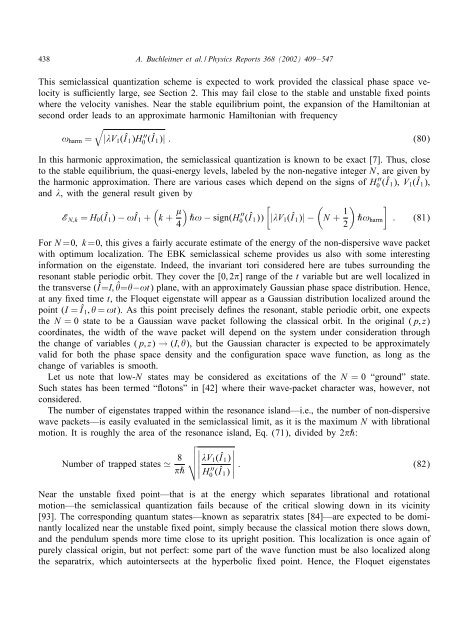Non-dispersive wave packets in periodically driven quantum systems
Non-dispersive wave packets in periodically driven quantum systems
Non-dispersive wave packets in periodically driven quantum systems
Create successful ePaper yourself
Turn your PDF publications into a flip-book with our unique Google optimized e-Paper software.
438 A. Buchleitner et al. / Physics Reports 368 (2002) 409–547<br />
This semiclassical quantization scheme is expected to work provided the classical phase space velocity<br />
is su ciently large, see Section 2. This may fail close to the stable and unstable xed po<strong>in</strong>ts<br />
where the velocity vanishes. Near the stable equilibrium po<strong>in</strong>t, the expansion of the Hamiltonian at<br />
second order leads to an approximate harmonic Hamiltonian with frequency<br />
!harm =<br />
<br />
| V1(Î 1)H ′′<br />
0 (Î 1)| : (80)<br />
In this harmonic approximation, the semiclassical quantization is known to be exact [7]. Thus, close<br />
to the stable equilibrium, the quasi-energy levels, labeled by the non-negative <strong>in</strong>teger N , are given by<br />
the harmonic approximation. There are various cases which depend on the signs of H ′′<br />
0 (Î 1), V1(Î 1),<br />
and , with the general result given by<br />
<br />
EN;k = H0(Î 1) − !Î 1 + k + ˝! − sign(H<br />
4<br />
′′<br />
0 (Î 1))<br />
<br />
| V1(Î 1)|− N + 1<br />
<br />
˝!harm<br />
2<br />
: (81)<br />
For N =0; k=0, this gives a fairly accurate estimate of the energy of the non-<strong>dispersive</strong> <strong>wave</strong> packet<br />
with optimum localization. The EBK semiclassical scheme provides us also with some <strong>in</strong>terest<strong>in</strong>g<br />
<strong>in</strong>formation on the eigenstate. Indeed, the <strong>in</strong>variant tori considered here are tubes surround<strong>in</strong>g the<br />
resonant stable periodic orbit. They cover the [0; 2 ] range of the t variable but are well localized <strong>in</strong><br />
the transverse (Î=I; ˆ = −!t) plane, with an approximately Gaussian phase space distribution. Hence,<br />
at any xed time t, the Floquet eigenstate will appear as a Gaussian distribution localized around the<br />
po<strong>in</strong>t (I = Î 1; = !t). As this po<strong>in</strong>t precisely de nes the resonant, stable periodic orbit, one expects<br />
the N = 0 state to be a Gaussian <strong>wave</strong> packet follow<strong>in</strong>g the classical orbit. In the orig<strong>in</strong>al (p; z)<br />
coord<strong>in</strong>ates, the width of the <strong>wave</strong> packet will depend on the system under consideration through<br />
the change of variables (p; z) → (I; ), but the Gaussian character is expected to be approximately<br />
valid for both the phase space density and the con guration space <strong>wave</strong> function, as long as the<br />
change of variables is smooth.<br />
Let us note that low-N states may be considered as excitations of the N = 0 “ground” state.<br />
Such states has been termed “ otons” <strong>in</strong> [42] where their <strong>wave</strong>-packet character was, however, not<br />
considered.<br />
The number of eigenstates trapped with<strong>in</strong> the resonance island—i.e., the number of non-<strong>dispersive</strong><br />
<strong>wave</strong> <strong>packets</strong>—is easily evaluated <strong>in</strong> the semiclassical limit, as it is the maximum N with librational<br />
motion. It is roughly the area of the resonance island, Eq. (71), divided by 2 ˝:<br />
Number of trapped states 8<br />
<br />
<br />
<br />
<br />
V1(Î 1)<br />
<br />
˝ H ′′<br />
0 (Î <br />
<br />
<br />
: (82)<br />
1) <br />
Near the unstable xed po<strong>in</strong>t—that is at the energy which separates librational and rotational<br />
motion—the semiclassical quantization fails because of the critical slow<strong>in</strong>g down <strong>in</strong> its vic<strong>in</strong>ity<br />
[93]. The correspond<strong>in</strong>g <strong>quantum</strong> states—known as separatrix states [84]—are expected to be dom<strong>in</strong>antly<br />
localized near the unstable xed po<strong>in</strong>t, simply because the classical motion there slows down,<br />
and the pendulum spends more time close to its upright position. This localization is once aga<strong>in</strong> of<br />
purely classical orig<strong>in</strong>, but not perfect: some part of the <strong>wave</strong> function must be also localized along<br />
the separatrix, which auto<strong>in</strong>tersects at the hyperbolic xed po<strong>in</strong>t. Hence, the Floquet eigenstates











